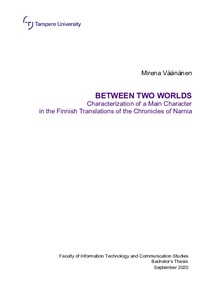Between Two Worlds. Characterization of a Main Character in the Finnish Translations of the Chronicles of Narnia
Väänänen, Mirena (2020)
Väänänen, Mirena
2020
Kielten kandidaattiohjelma - Bachelor's Programme in Languages
Informaatioteknologian ja viestinnän tiedekunta - Faculty of Information Technology and Communication Sciences
This publication is copyrighted. You may download, display and print it for Your own personal use. Commercial use is prohibited.
Hyväksymispäivämäärä
2020-09-21
Julkaisun pysyvä osoite on
https://urn.fi/URN:NBN:fi:tuni-202009086925
https://urn.fi/URN:NBN:fi:tuni-202009086925
Tiivistelmä
In my thesis I explore the translations of Clive Staples Lewis’ the Chronicles of Narnia from English into Finnish. The novels have been translated from English into Finnish by translators Kyllikki Hämäläinen and Kaarina Helakisa. The fantasy book series was first released in the 1950’s and has gained international popularity ever since, being viewed today as a literary classic. The novels have been translated into 47 different languages in total and have also been made into films. The hypothesis of my work is that even in a literary translation, domestication is used and that affects the way in which a character is viewed by the reader of a translation.
The aim of my research is to extract from the Chronicles of Narnia passages that feature the character of Edmund and explore his characterization and development as a character in light of translation studies. The method of my research is comparative analysis. I have included various passages from the novels in my thesis alongside with their Finnish translations, and I view from different translational perspectives how the character is portrayed in Finnish as opposed to in English. I have narrowed my investigation to the original English versions of the Chronicles of Narnia and their Finnish translations. As Edmund is not featured in all of them, I only include in my research the novels where he is present, videlicet The Lion, the Witch and the Wardrobe, Prince Caspian, The Voyage of the Dawn Treader and The Last Battle.
The theoretical basis of my thesis is domestication versus foreignization. I examine especially vocabulary but include some syntactic solutions as well. I concluded that the translators of the Narnia novels have appropriated the method of domestication in order for the text to have dynamic equivalence that makes reading the end result be a similar reading experience for a Finnish reader of a translation as it is for a British reader reading the original. Especially effective were the domesticating vocabulary changes. The translation has been quite free, especially translating idiomatic expressions and everyday language. The translators have tried to make the characters relatable by using domestication and this affects the characterization of Edmund. This makes the story more approachable, but also takes away some of the Britishness of the original work.
The aim of my research is to extract from the Chronicles of Narnia passages that feature the character of Edmund and explore his characterization and development as a character in light of translation studies. The method of my research is comparative analysis. I have included various passages from the novels in my thesis alongside with their Finnish translations, and I view from different translational perspectives how the character is portrayed in Finnish as opposed to in English. I have narrowed my investigation to the original English versions of the Chronicles of Narnia and their Finnish translations. As Edmund is not featured in all of them, I only include in my research the novels where he is present, videlicet The Lion, the Witch and the Wardrobe, Prince Caspian, The Voyage of the Dawn Treader and The Last Battle.
The theoretical basis of my thesis is domestication versus foreignization. I examine especially vocabulary but include some syntactic solutions as well. I concluded that the translators of the Narnia novels have appropriated the method of domestication in order for the text to have dynamic equivalence that makes reading the end result be a similar reading experience for a Finnish reader of a translation as it is for a British reader reading the original. Especially effective were the domesticating vocabulary changes. The translation has been quite free, especially translating idiomatic expressions and everyday language. The translators have tried to make the characters relatable by using domestication and this affects the characterization of Edmund. This makes the story more approachable, but also takes away some of the Britishness of the original work.
Kokoelmat
- Kandidaatintutkielmat [7051]
